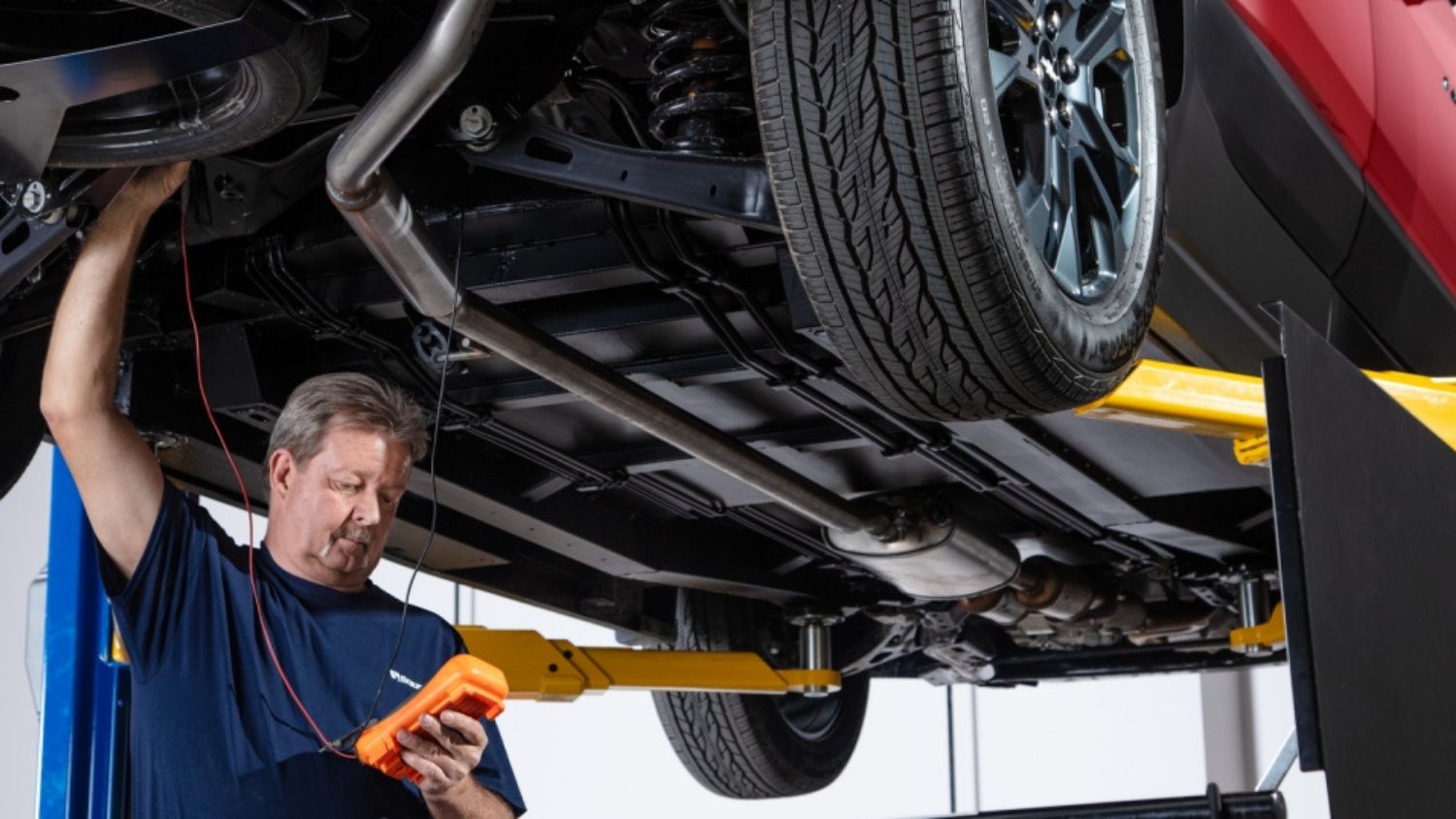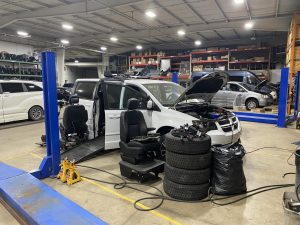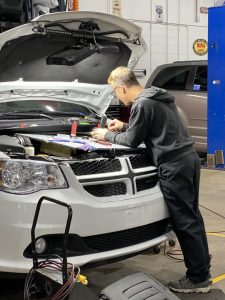
Wheelchair vans are undeniably one of the best investments to assist individuals with disabilities in traveling from one place to another without assistance or uncomfortable transfers. However, just like standard vehicles, these specialized vans are not immune to wear and tear.
Sure, a flickering dashboard light, a finicky wheelchair lift, or an unusual engine noise might initially seem trivial. Still, these seemingly minor issues can lead to sudden breakdowns or, worse, a life-threatening accident. That’s why regular wheelchair van maintenance isn’t just crucial — it’s an absolute necessity.
In this comprehensive article, we’ll share the benefits of wheelchair van care and how regular check-ups can prevent disastrous breakdowns and enhance your vehicle’s performance.
Safety Concerns Regarding Wheelchair Van
 According to the National Highway Traffic Safety Administration (NHTSA), vehicle malfunctions cause approx. 45,000 accidents per year, with many of those instances being linked to poor maintenance. Potential safety hazards from lack of maintenance include:
According to the National Highway Traffic Safety Administration (NHTSA), vehicle malfunctions cause approx. 45,000 accidents per year, with many of those instances being linked to poor maintenance. Potential safety hazards from lack of maintenance include:
- Tire Issues: Improperly maintained tires are a recipe for disaster. Bald tires, underinflation, or overly worn treads can affect grip, making vehicles susceptible to skidding, especially in wet or icy conditions. Poor tire maintenance also increases the risk of blowouts, which could lead to a sudden loss of control and possibly a rollover — a big issue at highway speeds.
- Faulty Brakes: When brake maintenance is neglected, pads wear down, and stopping distances increase, potentially failing to stop during critical moments. Additionally, malfunctioning brakes could suddenly engage, causing unexpected deceleration, easily resulting in rear-end collisions or intersection accidents.
- Malfunctioning Ramp or Lift: Wheelchair van ramps and lifts are the cornerstones of accessibility features. If these systems fail, it increases the risk of sudden falls or wheelchair tip-overs.
- Steering and Suspension Issues: Maintenance oversights can affect vehicle handling, increase steering effort, or cause a sudden change in direction — a serious problem at high speeds. Poor suspension can also lead to excessive vehicle bounce and sway, compromising stability and increasing the chance of vehicular rollover.
- Damaged Seat Belts: If seat belts crack, wear out, or sustain damage, they fail to protect passengers during accidents as needed. Unsecured occupants may be thrown around the vehicle or get ejected during a crash, resulting in head injuries, broken bones, and spinal injuries. The same goes for wheelchair securement and unmaintained kneeling systems.
- Air Conditioning and Heating Malfunctions: Lack of climate control in a wheelchair van can lead to overheating for both the engine and passengers, which can cause heat-related health issues, especially if you’re planning a summer trip. Similarly, an ineffective heater presents serious concerns in colder climates, potentially leading to hypothermia or fogged-up windows that impair the driver’s vision.
Ways to Prevent Wheelchair Van Breakdown
 Regular inspections and tune-ups are essential for avoiding roadside emergencies and unplanned repair bills. Ideally, you should follow the manufacturer’s recommended maintenance schedule for spark plugs, fluid changes, belt replacements, brake services, and other routine upkeep.
Regular inspections and tune-ups are essential for avoiding roadside emergencies and unplanned repair bills. Ideally, you should follow the manufacturer’s recommended maintenance schedule for spark plugs, fluid changes, belt replacements, brake services, and other routine upkeep.
If you don’t know the service history of your vehicle, you should take the following preventative measures before hitting the road:
- Check Fluid Levels: From engine oil, brake fluid, transmission fluid, power steering fluid, and coolant to windshield washer fluid — every liquid plays a crucial role. Ensure they’re all topped up and looking clear, not cloudy or gritty. In case of any leakage, take your vehicle to the mechanic immediately. As for frequency, you should change engine oil approximately every 3,000 to 5,000 miles. Transmission fluid usually has a longer life, but a good rule of thumb is to check it every 30,000 miles.
- Inspect Tires Regularly: All tires lose air with each drive and become worn out over time. Ideally, you should rotate tires every 6,000 to 8,000 miles. Also, make sure to check tire air pressure monthly and before long trips. To get an accurate pressure reading, check it when the tires are cold, meaning you haven’t driven your car for three hours. If the tread is worn down to 2/32 inches, it’s time to replace the tires with new ones. Similarly, if you notice your vehicle pulling to one side after any significant impacts like hitting a curb, check the wheel alignment for better control.
- Examine the Hand Controls: If your van is equipped with hand controls, make sure they’re working smoothly and don’t feel stiff or make any strange noises.
- Inspect Seat Belts and Wheelchair Tie-Downs: Regularly inspect wheelchair tie-downs and related seat belts for signs of wear, test latches for a secure hold, and always replace any part that looks frayed or isn’t functioning properly.
- Lubricate All Parts: Squeaky doors and stiff hinges don’t just sound annoying; they could point to future failures. Lubricate hinges, pivot points, lower door channels, and rollers for smooth operation.
- Inspect Ramp: Check the ramp to ensure it’s clear of debris, especially when it’s an in-floor wheelchair van. A clean ramp won’t jam or stutter when you need it the most.
- Check Exterior and Interior Lights: Make sure all lights, including turn indicators, headlights, emergency flashers, brake lights, and dashboard lights, are in working order.
While DIY maintenance is possible on some wheelchair vans, major services like transmission flushes, shocks and struts, and electric work must be left to qualified service technicians, like the team at Clock Mobility!
Like What you're reading? Subscribe to our Newsletter and get new updates directly to your inbox
Benefits of Regular Wheelchair Van Maintenance
 Below are some of the benefits of regular wheelchair van maintenance:
Below are some of the benefits of regular wheelchair van maintenance:
Better Performance
Over time, neglected maintenance might affect your vehicle’s performance. Your wheelchair van may experience reduced power, odd noises, shaky handling, or longer stopping distances. Regular upkeep helps optimize fuel efficiency, acceleration, ride quality, and other performance factors you rely on.
Low Repair Costs
Regular maintenance helps prevent costly repairs down the road by catching minor issues before they become major problems. Something as simple as an oil change, new filters, or lubricating parts can prevent engine or transmission failure. Replacing worn tires, brakes, belts, and hoses on schedule reduces the likelihood of being stranded on the road with an expensive towing and repair bill.
Increased Resale Value
In addition to preventing big-ticket repairs, wheelchair-accessible vans with complete service records and no deferred maintenance issues attract more customers and allow you to command a higher selling price when it’s time to trade in or sell.
Reduced Insurance Premium
Regular wheelchair van maintenance could also lead to lower insurance premiums. This is because properly maintained vehicles are less likely to break down or be involved in accidents due to mechanical issues. Additionally, the condition of your vehicle prior to an accident could influence the insurer’s evaluation of your claim and significantly impact your compensation for damages.
 Trust Clock Mobility for Peak Performance
Trust Clock Mobility for Peak Performance
When it comes to maintaining your wheelchair van, you need a company you can trust to get the job done right. With over 40 years of experience, Clock Mobility is the premier service provider for wheelchair van inspection, preventative maintenance, and electrical diagnostics. Our certified technicians and mechanics are well-versed in every specialized component of your van, from the wheelchair lift to hand controls and beyond.
For detailed cost estimations or to schedule a service appointment, please contact us at (866) 380-3326. Our professional and knowledgeable staff will guide you through the entire process for maximum satisfaction!
